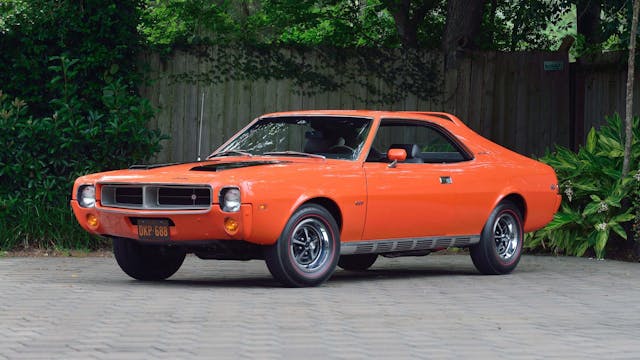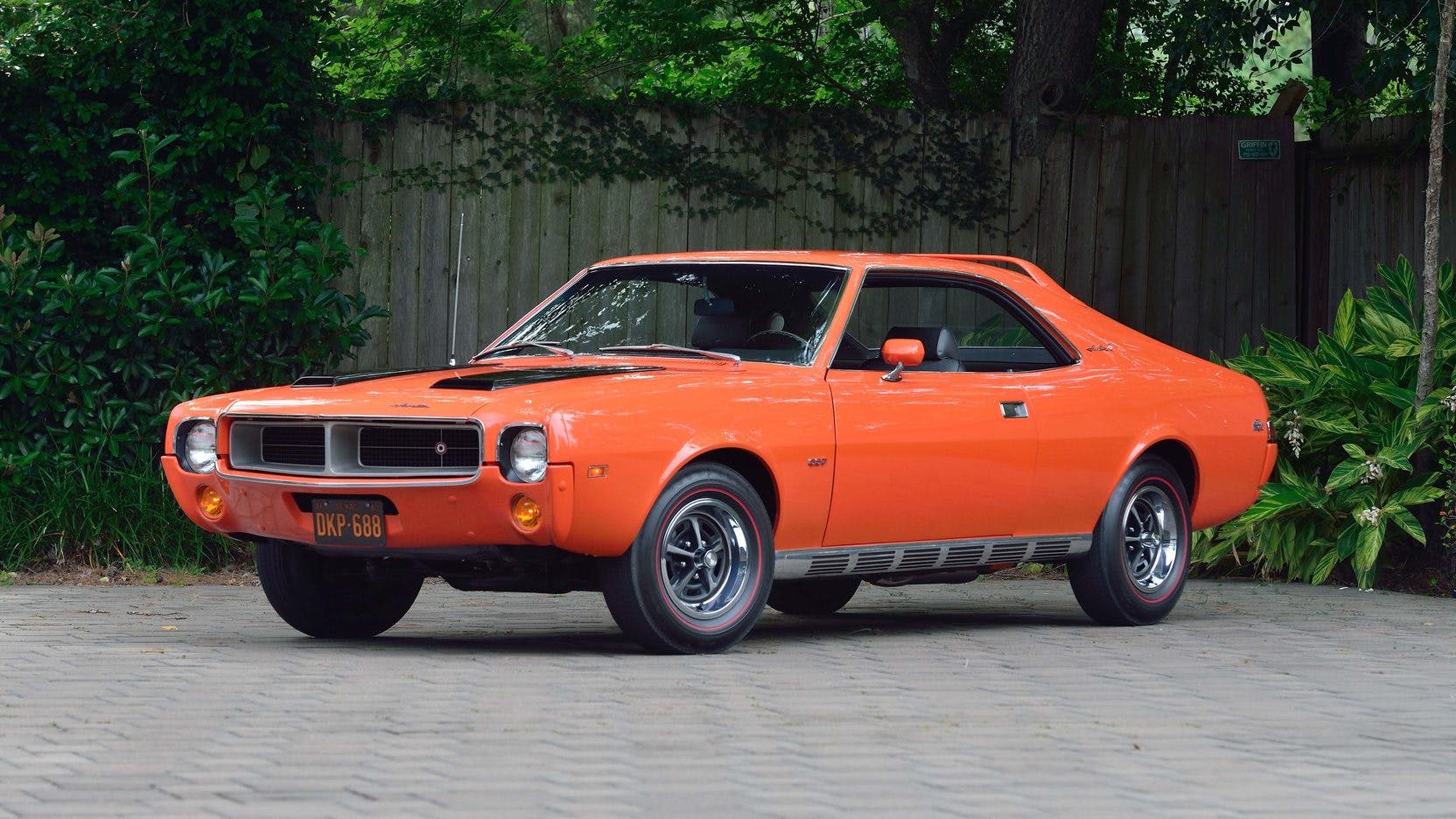Media | Articles
AMC values are finally stirring, but most remain Big Bad bargains
Ask the average person to name five American car companies: American Motors (AMC) isn’t likely to be on the list. Ask the average young person what they think about AMC, and they’ll probably start talking about movie-theater recliners. Too bad, because AMC is a carmaker worth remembering.
Formed in 1954 through what was then largest corporate merger in U.S. history, American Motors mostly paid the bills with smaller, lower-priced cars like the Rambler. And although money was always tight for the company from Kenosha, Wisconsin, it was the only American company standing against the Big Three in an era when Detroit was nearly all-powerful. AMC built one of the first true crossovers in the 1980 Eagle 4×4, and from 1970 until the buyout by Chrysler in 1987, AMC owned Jeep and oversaw some of Jeep’s greatest hits like the Scrambler CJ-8 and the original Grand Wagoneer. During the late ’60s and early ’70s, AMC also had a brief but memorable streak building performance cars.
It’s been over 30 years since the AMC brand went defunct, and the cars from Kenosha have generally possessed limited appeal, typically for people looking for an eccentric muscle car (or those who frequent Concours d’Lemons). Indeed, there aren’t many of the cars to go around. For every insurance quote that Hagerty gets for an AMC, we receive 70 for a Chevrolet. AMC values have also stayed lower and steadier than their Big Three rivals for years. For some, their affordability may be tempting, but parts are harder to find. Plus, AMCs haven’t generally been worth enough money to justify restoration, so pristine examples are rare.
Even so, with most classic cars appreciating over the past year, muscle cars included, the American Motors underdogs have been making more noise in the market. And with a big AMC collection set to cross the block at Mecum Indy next week, now seems like a good time to check in on what’s happening with the company’s most popular models.
1968–74 Javelin

Early AMC brochures didn’t have much to get excited about. Think “sensible,” not “sexy.” By the mid-1960s, though, the company needed an image boost. Enter the 1968 Javelin, a brash V-8 two-door built on a compact platform (from the Rambler American) and aimed squarely at the Mustang, Camaro, and Barracuda. AMC was several years late to the pony car party but, hey—better late than never.
Marketplace
Buy and sell classics with confidence
Available with several V-8s ranging from a 290-cubic-inch/225 hp mill to a 401/330 one, the Javelin got a facelift in 1970 and a thorough redesign in 1971 that gave the car its famous front wheelarches and long hood. Motor Trend called it “blatantly big, bold and brassy.” On track Roger Penske’s Javelins won the Trans Am title in 1971 and 1972, and in the showroom the Javelin was a success … at least for AMC. About 55,000 Javelins sold in 1968. That was cause for celebration in Wisconsin, but the same year Chevrolet sold 235,000 Camaros and Ford moved 300,000 Mustangs.
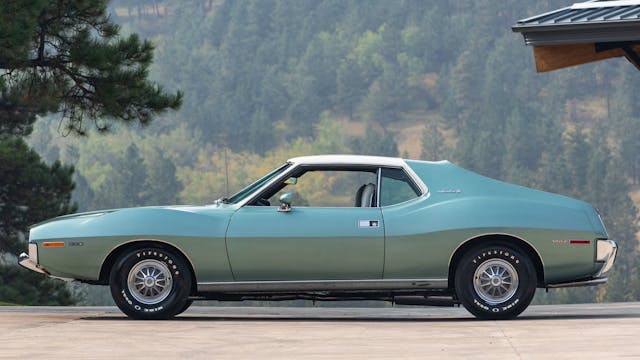
Almost 50 years after the last Javelins left Kenosha, they’re still significantly cheaper than their rivals from Detroit. The median condition #2 (Excellent) value is up 16 percent over the past five years but still sits at just $21,800. #2 values only range from the mid-teens for later, 1973 through ’74 base V-8 models to the mid- to high-20s for the high-performance SST and Javelin AMX.
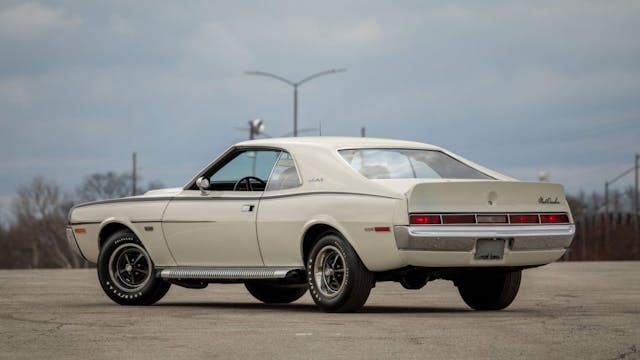
Desirable options include the popular “Go Package,” which wasn’t identical year-to-year but typically included heavy-duty suspension, dual exhaust, power front-disc brakes and an available limited-slip differential. (Add 10 to 30 percent for Go Package-equipped cars.) Starting in 1969, the “Big Bad” series of paint colors was introduced. (Add 25 percent to the price of a car with Big Bad paint.) The 1970 Javelin was also available with the Mark Donohue package, which was a special rear ducktail spoiler fitted to 2500 Javelin SSTs to homologate the spoiler for racing. (Plus 15 percent.) Even the nicest and most loaded Javelin, then, won’t break the bank—at least if you’re used to looking at household-name muscle cars.
1968–70 AMX
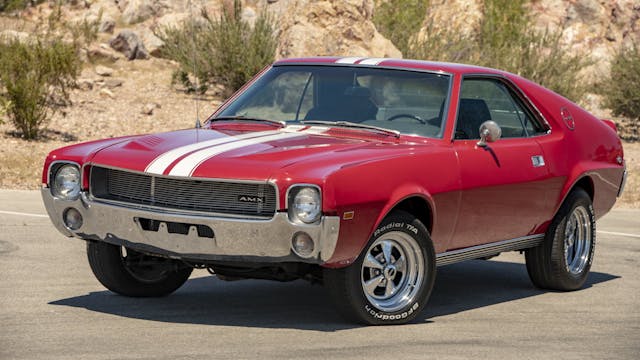
The second strike in AMC’s one-two performance punch in 1968 was the AMX. Though derived from the Javelin and powered by the same engines, the first-gen AMX was a distinct model. For one, AMC lopped a full foot from the Javelin’s greenhouse to make the new model a dedicated two-seater. This creative thinking made the AMX America’s only mass-produced two seater coupe other than the Corvette. The AMX was also a much cheaper option than America’s sports car, with a price of about $3500 compared to $4500 for the Vette. AMC played this up in a cheeky 1968 ad that sandwiched a new AMX between a 1957 C1 and a 1957 Ford Thunderbird, proclaiming “the first American sports car for under $3500 since 1957.”
After a short 1968 through 1970 production run, the AMX was discontinued as a separate model to become a performance package on the regular Javelin. The OG AMX remains one of only a handful of home-grown two-seaters.
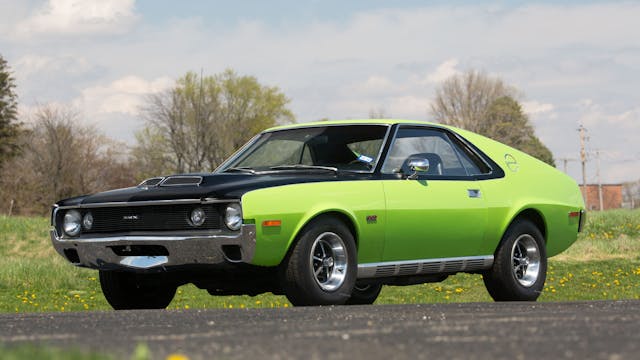
Super-rare variants of the AMX, like the AMX SS built by Hurst for racing, or the AMX 500 Special, which was built for Southern California AMC dealers, are holy grail cars for the AMC faithful (one 500 Special sold for $94,600 last year), but for the most part AMXs aren’t expensive cars. As when new, these cars remain performance bargains. The median #2 value for a 1968–70 AMX is $33,600; #2 values range from $27,200 for a 1968 model with the 290/225 engine to $52,100 for a 1970 model with the 390/325 hp engine. Add 20 percent for cars equipped with the “Go Package,” 25 to 30 percent for “Big Bad” paint schemes, and dock 20 for an automatic transmission.
Like values for most muscle cars, AMX prices dipped sharply during the Great Recession. They haven’t recovered their pre-2009 levels, either. Even so, the last few years have seen renewed interest in these offbeat two-seaters, especially over the last 12 months, and they’ve had a more pronounced upswing than their four-seat Javelin stablemates. Over the last three years the median #2 value is up 23 percent. With the latest update of the Hagerty Price Guide, #2 values are up anywhere from 8 percent to 17 percent depending on engine. With the number of insurance quotes and quoted values also nosing upward, it’s clear that more eyes are on the AMX—but they aren’t exactly new eyes. Millennials and Gen Zers quote fewer than 10 percent of AMXs. The renewed interest in AMC’s short-lived sports car is likely coming from boomers who either had an AMX when they were younger or are looking for a more affordable or more interesting alternative to the Big Three classics.
1969 SC/Rambler
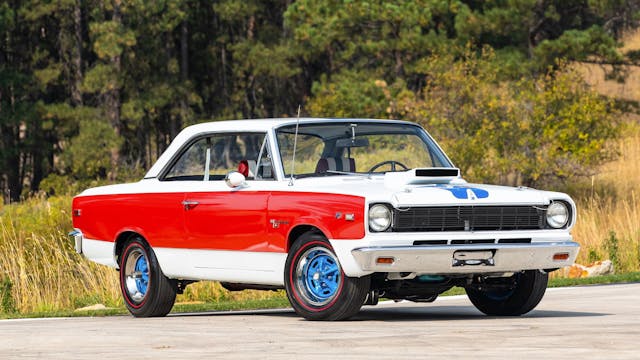
There are a few reasons why the SC/Rambler is so cool. It’s the concept of muscle car distilled to its purest form: The biggest V-8 available smashed into the smallest, lightest body in the lineup. Its sparse equipment didn’t simply keep the weight down; it also kept the SC/Rambler cheap. In 1969, this was the only car you could buy for under three grand that had over 300 hp and could pull 14-second quarter-miles. And just look at it. Is there anything more delightfully outrageous than a red, white, and blue look-at-me-mobile with decals that say “AIR” and a massive arrow pointing into a mailbox of a hood scoop?
Produced in conjunction with Hurst Performance Products, AMC’s smallest muscle car was based on a standard Rambler, which was endowed with a 390-cubic-inch/315 hp V-8 from the AMX, front sway bar, 3.54 limited-slip differential (called a “Twin-Grip” in AMC-speak), four-speed manual, heavy-duty brakes, and heavy-duty suspension. And so the Rambler became the SC/Rambler (the “SC” stands for “Super Car”). “With this car you could make life miserable for any GTO, Roadrunner, Cobra Jet or Mach 1,” ran a period ad. Indeed, the SC/Rambler, which was aimed at NHRA F-Stock drag racing, was both seriously fast and seriously affordable. Although AMC only planned to build around 500, the company ended up selling over 1500. About 80 percent of buyers chose the loud and proud “A” paint scheme with the decals, although a more conservative “B” scheme was available.
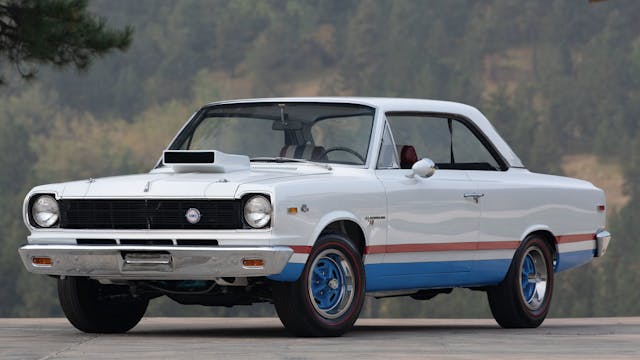
SC/Ramblers are the most valuable regular-production AMCs in the Hagerty Price Guide, but for four years their values didn’t move at all. Then, with the latest update of our pricing last month, #2 values jumped 12 percent to $62,200. About two-thirds of buyer interest comes from boomers, which makes sense given the SC/Rambler’s high price and its birth at the height of the muscle car era.
1970 Rebel Machine
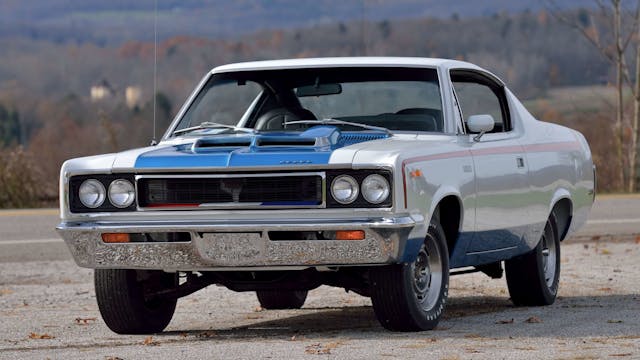
The one-year-only 1970 Rebel Machine is larger and less outrageous than the SC/Rambler that came before it, but that’s kind of like saying that Canada is colder than Finland. The Machine is still a bold bruiser with a gaping hood scoop and a patriotic paint scheme that shouts Francis Scott Key’s best from a mile away.
Based on AMC’s midsize Rambler Rebel, which competed with the likes of the Chevrolet Chevelle and Ford Torino, the Machine was developed by Hurst and was essentially a Rebel SST with a 390/340 hp engine and four-speed manual as well as hood-mounted tach, heavy-duty suspension with taller springs from a station wagon, a 3.91 Twin-Grip differential, and power disc brakes. After a little over 2300 examples of the factory hot-rod sold in 1970, AMC discontinued the model but kept the “Machine” name going on the new-for-1971 Matador with an available “Machine Go package.”
Another muscle car that dipped majorly during the Great Recession, the Rebel Machine has come back in a big way, particularly in the past three years. Its #2 value, currently at $55,900, is up 40 percent over the last three years and 72 percent over the last 10 years.
1970–78 Gremlin
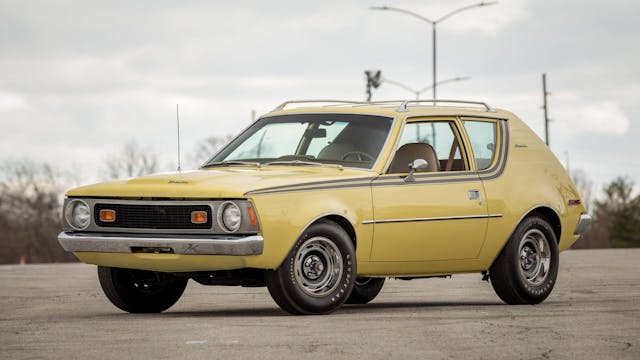
Humbly marketed as “the first American-built import,” the Gremlin was an economy car that shared the roads with such distinguished company as the Chevy Vega, Ford Pinto, and the onslaught of imports vying for the attention of newly fuel-conscious American drivers in the 1970s.
Named after a mythical creature that breaks machinery, the Gremlin was supposedly first sketched out by designer Dick Teague on the back of an airline barf bag. Even worse (or better?), the car’s official debut was on April Fool’s Day in 1970. The Gremlin seemed destined to be a four-wheeled punchline, but it was cheap and reasonably practical in a time when that’s exactly the kind of car Americans wanted. AMC sold over 670,000 Gremlins from 1970 through 1978.
How many of those are left? Well, not many. You’d have to be a special kind of person to be driving a Gremlin in 2022, but these little rolling doorstops do have a following. It’s a surprisingly young crowd, too. Maybe because Gremlins are cheap—or maybe because the youngest set relishes irony—but Gen Zers, who make up just 6 percent of the collector car market, account for 17 percent of insurance quotes for Gremlins. Millennials count for 22 percent, too. That’s unusual for a car this old, which few from either generation remember.
Although values remained essentially flat from 2017 until the beginning of last year, they shot up 17 percent over the last 12 months. Now, the median #2 value is $11,600. Gremlins with the “X” package (stripes and decals, body color front fascia, bucket seats, road wheels) are most desirable and add a 30 percent premium to Gremlins equipped with the available 304-cubic-inch V-8. Another kitschy ’70s option that can add 20 percent to the price of a Gremlin is the Levi’s package, which included spun nylon upholstery that looks like jeans.
1975–80 American Motors Pacer
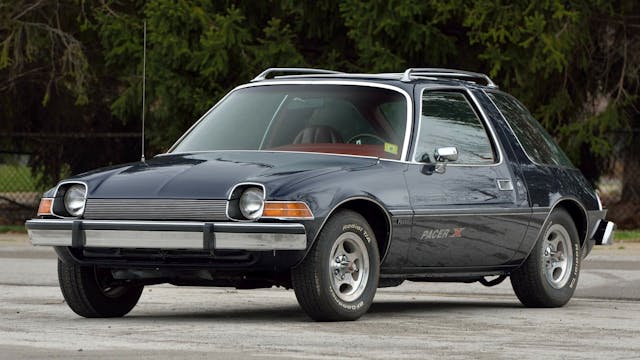
Following in the Gremlin’s footsteps, the Pacer debuted in 1975 with an ad claiming: “When you buy any other car, all you end up with is today’s car. When you get a Pacer, you get a piece of tomorrow.” Even though it was blessed with some clever features, like a longer passenger’s side door to facilitate back-seat access, the Pacer is mostly remembered as a car from yesterday that wasn’t very good and got too hot thanks to those huge windows.
Aside from Garth’s light blue, flame-decaled ’76 Pacer from Wayne’s World (which sold for $71,500, over four times its condition #1 value and almost double what it sold for back in 2016), Pacers are still among the cheapest of cheap classics. That said, the median condition #2 value in the Hagerty Price Guide is up 13 percent over the past three years to a nice round $10,000. Add 15 to 20 percent for special models like the Bicentennial edition or Limited package as well as a hefty premium for the 304-cubic-inch V-8 that arrived in 1978.
